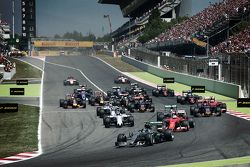Analysis: Why 'too-slow' F1 needs a big boost
After the Strategy Group flops of double-point finales and standing restarts, a Formula 1 overhaul to make cars dramatically faster has finally injected some positivity about the future.

Photo by: XPB Images



















And while the return of refuelling for 2017 may have divided opinion among fans, it is hard to find anyone unhappy about the prospect of grand prix machinery lapping up to six seconds quicker over the next two years.
Slow cars criticised
Lap times have been one of the big criticisms aimed at F1 since the current formula of 1.6-litre turbo V6 engines and new aero rules were introduced at the start of last season.
Despite the cars being quicker in a straight line, a combination of extra weight, conservative tyres and less downforce has led to a big increase in lap times.
A look back through the pole position times for the Spanish Grand Prix shows that in low-fuel trim, cars are around four seconds slower than they were at the end of the V8 era.
Perhaps most worrying of all is that they are not dramatically faster than other categories.
It was quite telling that Marcus Ericsson’s qualifying time for Sauber at Barcelona last weekend (1m28.112) was just six-tenths faster than his GP2 pole position time (1m28.706) from 2013.
Here is how the pole positions time for GP2 and F1 compare since the current configuration of Barcelona track was used since 2007...
|
Year |
GP2 pole |
F1 pole |
|
2007 |
87.713s |
81.421s* |
|
2008 |
87.547s |
81.813s* |
|
2009 |
87.510s |
80.527s* |
|
2010 |
87.727s |
79.995s |
|
2011 |
90.473s |
80.981s |
|
2012 |
90.655s |
82.285s |
|
2013 |
88.706s |
80.718s |
|
2014 |
89.293s |
85.232s |
|
2015 |
89.273 |
84.681 |
* – race fuel qualifying
The 10-second gap
But it is not qualifying that tells the full story of how much slower the current regulations have made F1.
It is only by looking at how slow cars are at the start of races – when drivers are hindered by a full 100kg fuel load and are mindful of managing degrading tyres – that the pace difference between flat-out F1 and now becomes apparent.
Looking at the opening flying laps of Spanish GPs dating back to 2007, the fastest laps were delivered when there was refuelling.
At F1’s race-pace peak in 2008, Kimi Raikkonen’s Ferrari delivered a blistering sequence of laps when racing began properly following an early safety car restart: 1m23.035s, 1m22.934s, 1m22.703s, 1m22.947s.
Fast forward to last weekend’s race, and the gulf becomes hugely apparent. Nico Rosberg’s opening laps were as follows: 1m32.313s, 1m31.755s, 1m32.027s, 1m31.908s.
Have those two cars racing on the same track and Raikkonen would be more than 35 seconds clear after four laps.
With a near 10-second difference from the flat out days, it is no wonder drivers complain about the current generation of F1 cars not delivering the challenge of the past.
|
Year |
Lap 2 |
Lap 3 |
Lap 4 |
Lap 5 |
Lap 2-5 total |
|
|
2007 |
83.751 |
83.561 |
83.017 |
83.109 |
333.438 |
|
|
2008 |
83.035 |
82.934 |
82.703 |
82.947 |
331.619 |
* SC start |
|
2009 |
84.325 |
83.898 |
83.849 |
83.744 |
335.816 |
* SC start |
|
2010 |
88.430 |
88.074 |
87.990 |
87.608 |
352.102 |
|
|
2011 |
90.812 |
90.606 |
90.012 |
90.318 |
361.748 |
|
|
2012 |
90.597 |
90.382 |
90.011 |
90.248 |
361.238 |
|
|
2013 |
91.123 |
91.188 |
90.671 |
91.064 |
364.046 |
|
|
2014 |
92.010 |
92.104 |
91.913 |
92.028 |
368.055 |
|
|
2015 |
92.313 |
91.755 |
92.027 |
91.908 |
368.003 |
Making the cars quicker
The return of refuelling will cut fuel loads by around 50kg for the start of the race, and a further 50kg cut in car weight that is possible would make a 100kg total reduction – equivalent to three seconds per lap.
Ramped up aerodynamics, more power, some more aggressive tyres, and the return of flat-out racing, should easily trim off a further two or three seconds to hit that magic six seconds target.
There is plenty of work to do yet before F1 is there: not least in framing a set of aerodynamic regulations that will deliver speed improvements, improve the looks and hopefully not make the racing worse.
But at least F1 has made a start in agreeing on some targets: now it is over to the genius engineering talent that inhabits the pit lane to deliver.
Be part of Motorsport community
Join the conversationShare Or Save This Story
Subscribe and access Motorsport.com with your ad-blocker.
From Formula 1 to MotoGP we report straight from the paddock because we love our sport, just like you. In order to keep delivering our expert journalism, our website uses advertising. Still, we want to give you the opportunity to enjoy an ad-free and tracker-free website and to continue using your adblocker.















Top Comments